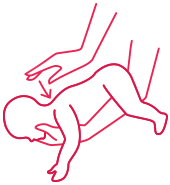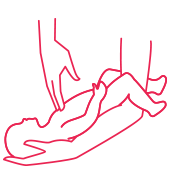Children, especially babies, are naturally curious. They want to explore the world around them and that usually means putting things in their mouths. You can try all you want to stop it, but eventually, something is going to make its into baby’s mouth.
Choking is the fourth leading cause of unintentional death in children under the age of 5. Every five days one child in the United States chokes to death, and 75% of those deaths happen in children under the age of 3. While the gag reflex can protect children from choking, the narrowness of their windpipes – compared to adults – makes choking a serious hazard.
Knowledge and prevention are the best tools to protect against choking, which is where we come in. We at Neighbors have put together a list of the 10 most common choking hazards for children and a quick recap on how to perform the Heimlich Maneuver on infants.
10 Most Common Choking Hazards
Two different studies in Pediatrics magazine have identified batteries, especially button batteries (used in wristwatches, remotes, clocks, etc…), as serious choking hazards. In addition, if swallowed they can cause severe tissue damage and result in fatal consequences. We encourage parents to keep any and all loose batteries locked away in a drawer or in a box on a shelf far from the reach of tiny hands.
Just like batteries, small magnets – like the ones often found on refrigerators or with magnetic toys – can be very dangerous. In 2008, there were more than 150 documented reports of children requiring emergency surgeries to remove magnets. Always keep magnets up high away from the reach of children.
Swallowing small objects can be benign. Small objects often simply pass through the digestive system, but items like coins, rocks, and marbles can pose a great risk. Never leave loose change in purses or pockets as they can easily fall onto the floor. It’s important to be hyper-vigilant when it comes to small rocks, marbles, and smaller toys. Keeping them off the floor is the best way to keep them out of babies’ mouths.
Although a staple at children’s birthday parties, balloons might not be as friendly as they appear. Balloons are responsible for almost half of all choking-related deaths. The March of Dimes has even branded balloons as “one of the most hazardous toys for children.” Balloons, especially latex, pop very easily. If pieces of latex are swallowed by accident, they can easily conform to the trachea and completely block the airway. Consider skipping the balloons on your child’s next birthday, or choose Mylar instead of Latex.
While they’re awesome for keeping kids occupied, especially during those summer months, art supplies can definitely pose a choking hazard. When kids are at a young age parents should avoid beads, buttons, and other small objects that a child could swallow in the blink of an eye. Also remember to choose non-toxic markers, paints, and crayons.
Uncut foods like grapes and blueberries are huge choking hazards due to their size, shape, and slipperiness. Other foods like strawberries and cherry tomatoes are also considered dangerous if swallowed whole. All foods mentioned here are considered a healthy part of a child’s diet but should be cut in half or even in quarters before being given to children.
It’s not just small round foods that are considered dangerous, but sticky foods as well. Many parents tend to avoid giving their children peanut butter until after their first birthday, but it’s not just due to allergies. Sticky foods can make it difficult for children to swallow which can then cause choking.
Hot dogs are the number one food-related choking hazard for children. In 2010, the AAP called on the government to mandate that hot dog manufacturers put warning labels on their packaging. The reason? Its shape. If eaten whole, the cylindrical shape of this summertime favorite poses a great danger as it can completely block a child’s airway. It’s recommended that hot dogs be cut into small pieces at least until a child’s third birthday.
What Do I Do if My Child is Choking?
Sometimes accidents happen and kids end up inadvertently swallowing something and choking. If this happens, the first step is not to panic. There are steps you can take to dislodge the obstruction. Below are the steps for the infant Heimlich maneuver, as well as other ways to eject the item:

Infant Heimlich
- Resting your forearm on your leg, place the infant face down across your forearm, and support the infant’s head with your hand.
- With the heel of your other hand, give four forceful blows to the infant’s back.
- You may have to repeat this several times until the obstructing object is coughed out.

Alternative Method of Dislodging Tracheal Obstruction
- With two fingers one finger width below the imaginary line connecting the nipples, give four forceful thrusts to the chest to a depth of 1 inch.
- You may have to repeat this several times until the obstructing object is coughed out.
It’s Not Just Children
While children are more likely to choke, anyone can inadvertently swallow something and end up choking. In addition, senior citizens are also susceptible to choking, due to issues like dysphagia or difficulty swallowing. Take a look at our blog on the Heimlich maneuver to get an overview of how to help anyone who might be choking. If you’re a parent or caregiver, it might also be helpful to get certified in CPR and other first-aid techniques (like the Heimlich). You never know when they might come in handy.
Visit the Houston Red Cross website to find first aid classes near you. Neighbors locations also offer free first aid classes periodically. You can like and follow Neighbors on all our social channels for updates on upcoming CPR classes.
Choking is a scary scenario, but when you arm yourself with knowledge of how to prevent it – and what to do just in case it happens – the chances of survival are much higher. Keep a watchful eye on children and seniors at mealtime, put any choking hazards out of reach of children, and familiarize yourself with the steps needed to provide life-saving assistance in case of an emergency. And remember, your best Neighbors ever are just down the road if you need us.
